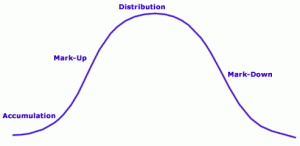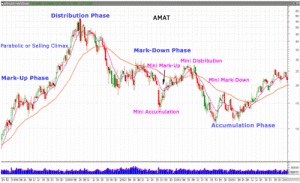We’ve all heard of market bubbles and many of us know someone who’s been caught in one. Although there are plenty of lessons to be learned from past bubbles, market participants still get sucked in each time a new one comes around. A bubble is only one part of an important phase in markets, so if you want to avoid being caught off guard, it is essential to know what the different phases are. An understanding of how markets work and a good grasp of technical analysis can help you recognize market cycles. (To read about history’s greatest market crashes, check out The Greatest Market Crashes.)
The Four Phases
Cycles are prevalent in all aspects of life; they range from the very short term, like the life cycle of a June bug, which lives only a few days, to the life cycle of a planet, which takes billions of years.
No matter what market you are referring to, all have similar characteristics and go through the same phases. All markets are cyclical. They go up, peak, go down and then bottom. When one cycle is finished, the next begins.
The problem is that most investors and traders either fail to recognize that markets are cyclical or forget to expect the end of the current market phase. Another significant challenge is that, even when you accept the existence of cycles, it is nearly impossible to pick the top or bottom of one. But an understanding of cycles is essential if you want to maximize investment or trading returns. Here are the four major components of a market cycle and how you can recognize them. (For more on how to recognize market cycles, read Sector Rotation: The Essentials.)
Accumulation Phase
This phase occurs after the market has bottomed and the innovators (corporate insiders and a few value investors) and early adopters (smart money managers and experienced traders) begin to buy, figuring that the worst is over. At this phase, valuations are very attractive, and general market sentiment is still bearish. Articles in the media preach doom and gloom, and those who were long through the worst of the bear market have recently capitulated, that is, given up and sold the rest of their holdings in disgust. But in the accumulation phase, prices have flattened and for every seller throwing in the towel, someone is there to pick it up at a healthy discount. Overall market sentiment begins to switch from negative to neutral.
Mark-Up Phase
At this stage, the market has been stable for a while and is beginning to move higher. The early majority are getting on the bandwagon. This group includes technicians who, seeing that the market is putting in higher lows and higher highs, recognize that market direction and sentiment have changed. Media stories begin to discuss the possibility that the worst is over, but unemployment continues to rise, as do reports of layoffs in many sectors. As this phase matures, more investors jump on the bandwagon as fear of being in the market is supplanted by greed and the fear of being left out.
As this phase begins to come to an end, the late majority jump in and market volumes begin to increase substantially. At this point, the greater fool theory prevails. Valuations climb well beyond historic norms, and logic and reason take a back seat to greed. While the late majority are getting in, the smart money and insiders are unloading. But as prices begin to level off, or as the rise slows down, those laggards who have been sitting on the sidelines see this as a buying opportunity and jump in en masse. Prices make one last parabolic move, known in technical analysis as a selling climax, when the largest gains in the shortest periods often occur. But the cycle is nearing the top of the bubble. Sentiment moves from neutral to bullish to downright euphoric during this phase. (For more, read The Stock Cycle: What Goes Up Must Come Down.)
Distribution Phase
In the third phase of the market cycle, sellers begin to dominate. This part of the cycle is identified by a period in which the bullish sentiment of the previous phase turns into a mixed sentiment. Prices can often stay locked in a trading range that can last a few weeks or even months. For example, when the Dow Jones Industrial Average (DJIA) peaked in Jan 2000, it traded down to the vicinity of its prior peak and stayed there over a period of more than 18 months. But the distribution phase can come and go quickly; for the Nasdaq Composite, the distribution phase was less than a month long, as it peaked in Mar 2000 and then retreated shortly thereafter. When this phase is over, the market reverses direction. Classic patterns like double and triple tops, as well as head and shoulders top patterns, are examples of movements that occur during the distribution phase. (For more on understanding moves in the major indexes, read How Now, Dow? What Moves The DJIA?)
The distribution phase is a very emotional time for the markets, as investors are gripped by periods of complete fear interspersed with hope and even greed as the market may at times appear to be taking off again. Valuations are extreme in many issues and value investors have long been sitting on the sidelines. Sentiment slowly but surely begins to change, but this transition can happen quickly if accelerated by a strongly negative geopolitical event or extremely bad economic news. Those who are unable to sell for a profit settle for a breakeven or a small loss.
Figure 1: The Four Phases of an Investment Cycle
Mark-Down Phase
The fourth and final phase in the cycle is the most painful for those who still hold positions. Many hang on because their investment has fallen below what they paid for it, behaving like the pirate who falls overboard clutching a bar of gold, refusing to let go in the vain hope of being rescued. It is only when the market has plunged 50% or more that the laggards, many of whom bought during the distribution or early mark-down phase, give up or capitulate. Unfortunately, this is a buy signal for early innovators and a sign that a bottom is imminent. But alas, it is new investors who will buy the depreciated investment during the next accumulation phase and enjoy the next mark-up.
Timing
A cycle can last anywhere from a few weeks to a number of years, depending on the market in question and the time horizon at which you are looking. A day trader using five-minute bars may see four or more complete cycles per day while, for a real estate investor, a cycle may last 18-20 years.
Figure 2: Weekly chart of Applied Materials (AMAT) from late 1998 to early 2004 showing different market phases and one cycle of mini-phases with 10-week (purple line) and 50-week (orange line) moving averages.
The Presidential Cycle
One of the best examples of the cycle phenomenon is the effect of the four-year presidential cycle on the stock market, real estate, bonds and commodities. The theory about this cycle states that economic sacrifices are generally made during the first two years of a president’s mandate. As the election draws nearer, administrations have a habit of doing everything they can to stimulate the economy so that voters go to the polls with jobs and a feeling of economic well being.
Interest rates are generally lower in the year of an election, so experienced mortgage brokers and real estate agents often advise clients to schedule mortgages to come due just prior to an election. This strategy has worked quite well during the last 16 years. The stock market has also benefited from increased spending and decreased interest rates leading up to an election, as was certainly the case in the 1996 and 2000 elections. Presidents know that if voters are not happy about the economy when they go to the polls, chances for re-election are slim to none, as George Bush Sr. learned the hard way in 1992.
Summing Up
Although not always obvious, cycles exist in all markets. For the smart money, the accumulation phase is the time to buy because values have stopped falling and everyone else is still bearish. These types of investors are also called contrarians since they are going against the common market sentiment at the time. These same folks sell as markets enter the final stage of mark-up, which is known as the parabolic or buying climax. This is when values are climbing fastest and sentiment is most bullish, which means the market is getting ready to reverse.
Smart investors who recognize the different parts of a market cycle are more able to take advantage of them to profit. They are also less likely to get fooled into buying at the worst possible time. (How can you get back into the market to avoid missing market recovery gains? Find out in Riding The Bear Into A Bull Market.)
Source: investopedia.com

